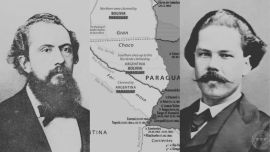Since today is the 209th anniversary of the birth of Argentine nationhood, it would not be amiss to start our look at the 18th province in this series – Salta – with a reference to those times. The independence cause back then was championed by the local gauchos under Martín Miguel de Güemes (a Spanish corruption of the Scottish surname Wemyss, a Jacobite ancestor, according to some sources) and opposed not only by the forces of the Spanish Crown but also by the strong royalist sentiments of the local patrician families (including the ancestors of current Peronist Governor Juan Manuel Urtubey), who fearfully equated independence with indigenous empowerment.
Such divisions persist to this day. The upcoming June 17 public holiday commemorating the anniversary of Güemes’ “passage to immortality” in 1821 originated in 2010 under the presidency of the brand-new vice-presidential candidate Cristina Fernández de Kirchner when it was declared Latin American Freedom Day even if only enshrined as a public holiday by a strongly Peronist Congress in 2016. Arguably the most anti-Kirchnerite of the traditional Peronists, Urtubey’s contemptuous dismissal of the Alberto Fernández-Cristina Fernández de Kirchner ticket this week was worthy of his royalist ancestors – “less of the same” (by which he clearly meant an inferior rather than a more moderate version).
Since Salta does not vote until November 10 (the only province to go to the polls between the two rounds of presidential voting), little sense in going too deeply into the candidates or the opinion polls for the provincial elections – especially given the seismic shift in the electoral panorama in just the past week. Three-term Governor Urtubey (first elected at the age of 37) is himself out of this picture, pursuing uncertain presidential ambitions – curious how being telegenic, charismatic and articulate can sometimes count for so little in the opinion polls. His prospective heirs include his LieutenantGovernor Miguel Isa and provincial capital mayor Gustavo Sáenz, who has played both sides – Sergio Massa’s running-mate in 2015, he all but enrolled in Cambiemos following the national government’s midterm triumph in 2017 but must surely be rethinking that alignment following the ruling coalition’s disastrous string of results so far this year.
A pioneer of electronic voting alongside this city in 2013, Salta will be employing the single ballot this year. Salta has always been governed by generally centre-right Peronists since 1983, apart from the 1991-1995 period when it was ruled by 1977-1983 military trustee Roberto Ulloa, a right-wing naval officer who won election under the Renewal Party label. PreUrtubey Peronism was dominated by the Romero dynasty – founder Roberto (who governed 1983-1987 and perished in a 1992 road accident like Córdoba’s late José Manuel de la Sota) and his son current Senator Juan Carlos Romero (three-term governor between 1995 and 2007). Salta’s presidential voting since 1983 is more uneven – it twice voted for a Radical (Eduardo Angeloz in 1989 and Fernando de la Rúa in 1999) and preferred Carlos Menem to Néstor Kirchner in 2003 when Romero was Menem’s running-mate.
Before it elects its next governor, Salta will be renewing its national Congress representation in both Houses – all three senators and four of its seven deputies. All three senators respond to past and present governors – the Peronists are ex-governor Romero and the current governor’s brother Rodolfo Urtubey while María Cristina del Valle Fiore Viñuales represents Ulloa’s Renewal Party. Urtubey has remained in the majority caucus of the Federal Peronists under Miguel Angel Pichetto but Romero has formed his own five-member splinter, including Fiore Viñuales.
The four deputies vacating their seats this year are the Peronists Pablo Kosiner and Javier David, Radical Miguel Nanni and the eccentric populist Alfredo Olmedo (he of the yellow jacket) for the rightist Salta Somos Todos. Kosiner heads the Lower House Justicialist caucus and is a frequent media touchstone when an opinion for the middle ground between the Mauricio Macri administration and Kirchnerism is sought. PRO’s Martín Grande, the Victory Front’s Sergio Napoleón Leavy and Peronist Andrés Zottos (previously a two-term lieutenant-governor and possible gubernatorial candidate) stay put until 2021.
Despite the often outrageous outbursts of presidential hopeful Olmedo and the centreright leanings of most Peronists, Salta is also something of a leftist stronghold – clinching third place in 2015, the Trotskyist PO Workers Party topped the provincial capital vote in 2017 with over 27 percent. Curiously enough, Salta is not only a leftist but also an Anglican stronghold – over a century ago Anglican missionaries stepped into the vacuum left by the established church in the province’s eastern Chaco half with the result that Argentina’s two Church of England dioceses are based on two highly contrasting congregations, the AngloArgentines of this capital and the indigenous of Salta.
A still strong indigenous culture (Wichi and Qom) accounts for over 95 percent of some 12 millennia of human settlement with the first Spanish explorers arriving in 1535. The provincial capital was founded as San Felipe de Valle de Salta in 1582 (its 4th centennial festivities in 1982 had to be cancelled because Argentina was at war with Britain at the time).
Under Tucumán in colonial times, the province was created by decree in 1814 after the famous battle of 1813, although often in the hands of first local and then High Peru (Bolivian) royalists through to 1821, while Jujuy separated in 1834. There were 67 pre-democratic governors (including four with the Güemes surname and several with such patrician names as Saravia, Uriburu or Patrón Costas) while trustees outnumbered elected governors by 39 to 16 in the generally unstable 1919-1983 period – working-class Peronist Miguel Ragone (considered a Communist by the local élites) disappeared a fortnight before the 1976 coup.
Salta has a population of around 1.4 million with a sevendigit electorate. Almost half the population (some 650,000) live in the provincial capital while Orán (over 80,000) and the oil town of Tartagal (75,000) are other important cities – 11 more of the 58 towns in its 23 departments have five-digit populations. An unusually high proportion of its immigrant communities have Levantine (Syria and Lebanon) origins, including the Romeros.
The province is clearly divided into mountainous western and Chaco eastern halves with most of the tourist delights in the former. These include the provincial capital (“La Linda”) with its magnificent cathedral and colonial architecture. The Tren de las Nubes reaching altitudes of almost 4,000 metres is a star attraction but in general the mountain scenery is strikingly beautiful. Cachi as a showcase of indigenous handicrafts, Cafayate combining cactus with often unique wines (Torrontes) and the three national parks are also well worth a visit. Salta is arguably the most Latin American of all Argentine provinces.
#18 Salta
Electorate (2017): 991,299
Governor: Juan Manuel Urtubey (Peronist)
Senators: Three (2 Peronist, 1 Salta Renewal)
Deputies: 7 (3 Peronists, 2 Cambiemos including 1 Radical and 1 PRO, 1 Victory Front, 1 Salta Somos Todos)
On the ballot: 3 senators, 4 of 7 deputies
























Comments